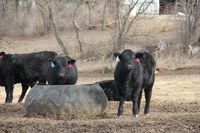Prevent Hardware Disease in Cattle
(Click the image below to view a high-resolution image that can be downloaded)
Inverted tires can make great containers to hold cattle feed and water, but tires also can pose health risks for the animals if the tires aren’t maintained regularly.
“If the tires you are using on your operation have wire in the walls, this wire can break off and subsequently be consumed by cattle,” warns North Dakota State University Extension Service beef cattle specialist Carl Dahlen. “Cattle ingesting these pieces of wire can develop a condition known as hardware disease.”
Once wire is swallowed, it goes into the digestive system and often gets trapped in the chamber of the stomach called the reticulum. The reticulum has honeycomb-shaped structures on the walls and is designed to trap foreign materials. If the wire punctures the reticulum wall, stomach contents can leak through the wall and cause a condition called peritonitis. Peritonitis can lead to poor health and also may cause systemic infections. Cattle that continually decline in health eventually may need to be culled.
Metal, wire and other foreign materials in the reticulum also can lead to sudden death, Dahlen says. The diaphragm is the thin muscle that divides the abdominal cavity (which contains the stomach, intestine, liver, etc.) from the thoracic cavity (which contains the heart and lungs). The reticulum and heart are close to each other, separated only by the diaphragm. In instances when cattle experience severe abdominal contractions, such as while delivering a calf, foreign material in the reticulum can be forced through the reticulum wall and into the heart.
“If this happens, the animal will die shortly thereafter,” Dahlen says. “Alternatively, the metal may pierce only the protective layers around the heart and cause inflammation and/or infection. Either way, it is not a good situation.”
To avoid hardware disease, perform regular maintenance on your tire feeders. Maintenance should include:
- Cutting or grinding off exposed wire, and picking up pieces and removing them from the cattle-feeding area
- Removing any wire, nails or other metal scraps from areas to which cattle have access
- Including powerful magnets in feed mixers
NDSU Agriculture Communication - Feb. 9, 2012
| Source: | Carl Dahlen, (701) 231-5588, carl.dahlen@ndsu.edu |
|---|---|
| Editor: | Ellen Crawford, (701) 231-5391, ellen.crawford@ndsu.edu |


